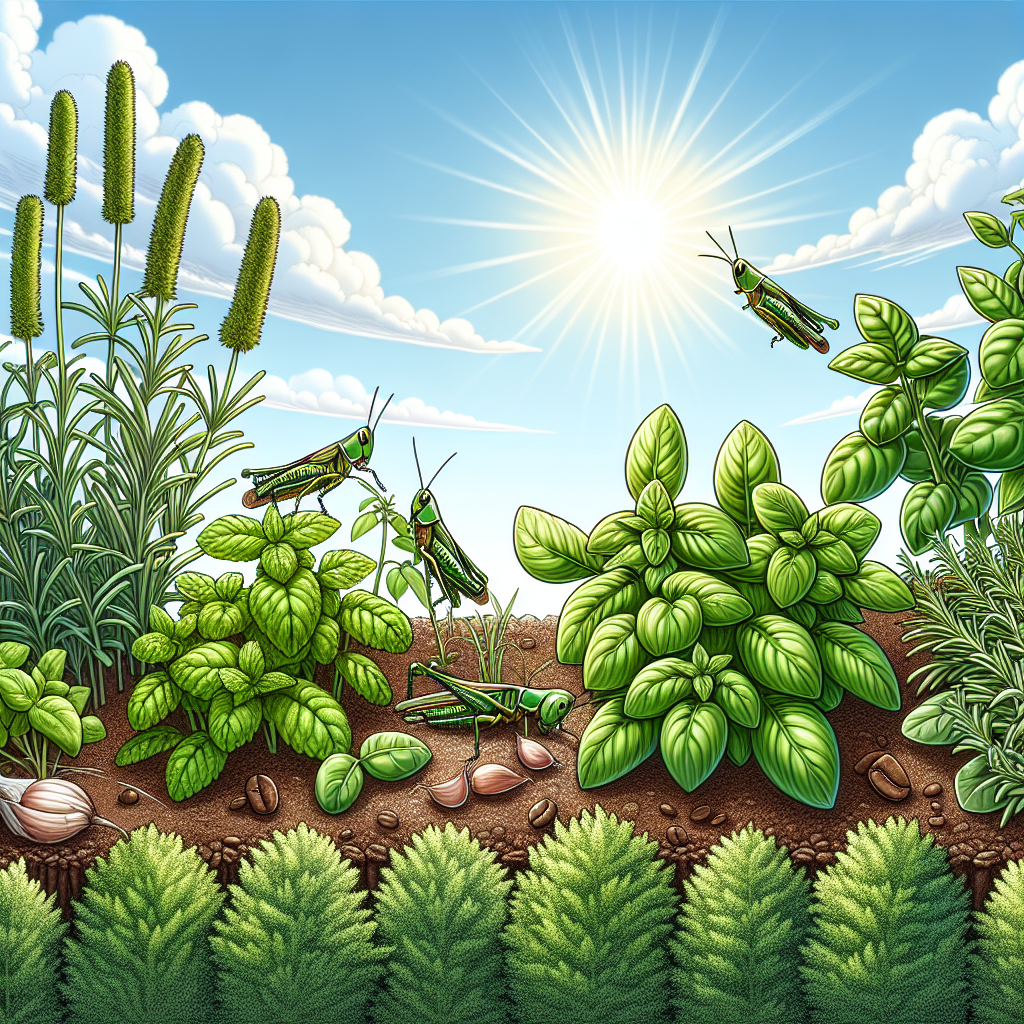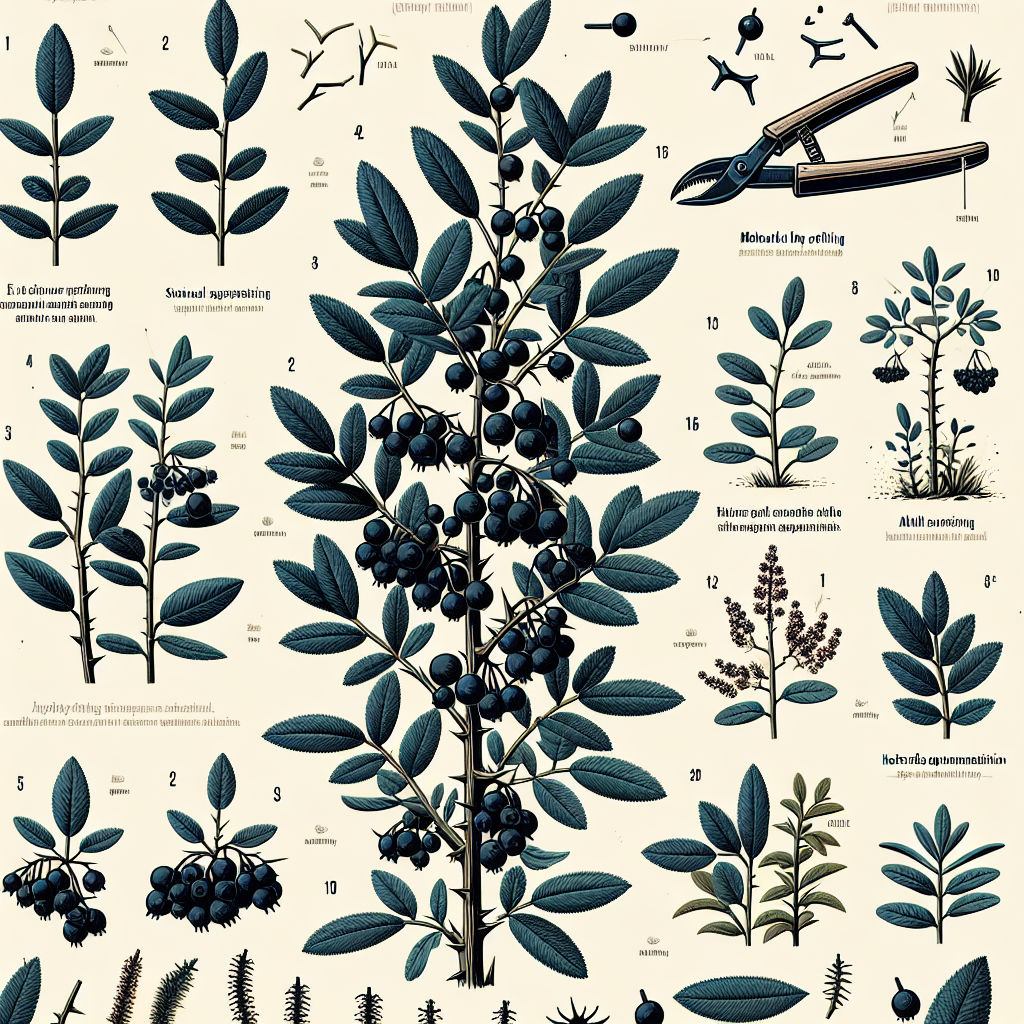How to Keep Grasshoppers Off Your Herbs
Updated April 16, 2024 at 7:59 am
Discover natural and effective strategies to protect your precious herbs from pesky grasshoppers, ensuring your garden thrives without the use of harsh chemicals.

Understanding Grasshoppers and Your Herb Garden
Grasshoppers are a common pest in gardens and can pose a significant threat to your herbs. They can devour whole plants at an alarming rate, making it imperative to protect your herb garden from these voracious insects. Before we dive into solutions, it’s important to recognize the signs of grasshopper damage: they typically leave chewed leaves and notches along the edges. If you spot these signs, it’s time to take action.
Creating Physical Barriers
One effective method in keeping grasshoppers at bay is through the use of physical barriers. Products like garden netting or floating row covers can be placed over your herbs to physically block grasshoppers from reaching the plants. Ensure the edges are well secured, as grasshoppers are adept jumpers and can easily overcome poorly installed barriers.
For instance, the Agribon AG-19 Floating Row Crop Cover is a popular choice among gardeners. It’s light enough to lay directly over plants without causing damage and allows for 85% light transmission. Users have shared that it not only protects herbs from grasshoppers but also from the damaging effects of frost and other pests, making it a multi-functional tool in the garden.
Find This and More on Amazon
Using Natural Predators to Your Advantage
Introducing natural predators like birds and beneficial insects can help control grasshopper populations. Encouraging birds by setting up birdhouses or providing bird feeders will increase the number of feathered allies visiting your garden for a grasshopper feast.
Ladybugs and predatory wasps are excellent at controlling pests. You can purchase live ladybugs and release them into your garden, which if done in the evening, increases the likelihood they will stay and get to work in your herb garden. There are various online retailers where you can order live ladybugs, and customers often share how these friendly insects have helped restore balance in their garden ecosystem.
Organic Insecticides as a Solution
If the grasshopper infestation is severe, organic insecticides may be a solution. Diatomaceous earth is a non-toxic powder made from the fossilized remains of microscopic creatures. When grasshoppers come into contact with it, it damages their exoskeleton and dehydrates them. Sprinkle it around your herbs, focusing on the soil surrounding the plants where grasshoppers might land.
Another option is neem oil, an organic insecticide that disrupts the life cycle of grasshoppers. It’s best to apply neem oil during cooler parts of the day, early morning or late evening, to avoid leaf burn. Follow the instructions for mixing and application as provided on products like Garden Safe Brand Neem Oil Extract Concentrate. Users have praised its effectiveness not just for grasshoppers, but for a wide spectrum of garden pests.
Find This and More on Amazon
Interplanting as a Grasshopper Deterrent
Grasshoppers dislike certain plants, and interplanting these with your herbs can act as a natural deterrent. For example, garlic, calendula, and cilantro are known to repel grasshoppers. Planting a border of these around your herbs can create a protective zone, and you’ll be adding variety to your garden at the same time.
Interplanting also promotes a principle known in the gardening world as companion planting, where placing certain plants together can naturally fend off pests. For ideas on what plants work well together, consider looking at resources like “The Vegetable Gardener’s Guide to Permaculture: Creating an Edible Ecosystem,” which has excellent reviews from gardeners who’ve found the interplanting charts and guides particularly helpful.
Homemade Repellents and Deterrents
If you prefer a more hands-on approach, homemade repellents can be an effective and cost-saving method. A popular recipe among gardeners combines onion, garlic, cayenne pepper, and water, blended and left to sit overnight then strained and sprayed onto the plants. Not only is it organic, but it also incorporates items commonly found in your kitchen.
When creating and applying homemade repellents, it’s essential to exercise caution and regularly observe your plants for any signs of adverse reactions. While these mixtures are generally safe, every plant species has different sensitivities.
Timing Your Planting
Grasshoppers lay eggs in fall that hatch in spring, so timing your planting to avoid peak grasshopper seasons can reduce their impact. Early planting and harvesting can mean your herbs are mature and less susceptible to damage when young grasshoppers emerge and are most hungry.
Also, rotating your crops annually so that grasshoppers cannot establish a reliable food source in a single location year after year can make your herb garden less inviting. Some gardening enthusiasts swear by this method, noting a clear decrease in pest problems when following a meticulous crop rotation schedule.
Diligent Garden Maintenance
Keeping your garden tidy goes a long way in preventing grasshopper infestations. Regularly remove weeds and plant debris where grasshoppers may breed or hide. Proper garden sanitation might not seem like much, but it makes a significant difference in keeping pests under control.
This practice also promotes good airflow and reduces the risk of plant diseases, which can increase the resilience of your herbs against pests. Many gardeners find that a clean garden is not only visually pleasing but also healthier overall, with fewer pest issues.
Insect Growth Regulators
Insect Growth Regulators (IGRs) like Nolo Bait or Semaspore are specific to grasshoppers and locusts, and when applied to your garden, they can inhibit their growth. These products contain a fungus that is harmless to plants and other animals but deadly to grasshoppers.
Since IGRs target the molting process of grasshoppers, they’re considered more humane and eco-friendly. The use of Nolo Bait, in particular, has gained a strong following, with users often reporting reductions in grasshopper populations without harming other wildlife.
Barriers and Repellents: A Winning Combination
Combining barriers and repellents offers a one-two punch against grasshoppers. By protecting your herbs with netting and using deterrents like neem oil or homemade sprays, you’re implementing a comprehensive strategy that covers all bases.
Gardeners who’ve adopted a multi-pronged approach often share their success stories, delighting in an herb garden that thrives without chemical pesticides. The diverse tactics complement each other, yielding a harmonious garden ecosystem with minimal grasshopper damage.
Monitor and Adjust Your Methods Regularly
Dealing with grasshoppers is not a set-it-and-forget-it situation. It’s vital to regularly monitor your herbs for signs of grasshopper activity and to adjust your strategies as needed. This might mean reapplying organic insecticides after rain or reinforcing your physical barriers if you notice breaches.
Many successful gardeners share that vigilance is key. By staying observant and responsive, you can adapt your methods throughout the growing season, ensuring that your herbs remain protected and productive.
Connect with Other Gardeners for Tips and Tricks
Lastly, don’t overlook the value of community knowledge. Connecting with other gardeners through forums, social media groups, or local gardening clubs can provide a wealth of information and support. You might discover new ideas or subtle tips that can make all the difference in your herb garden’s defense against grasshoppers.
Those who engage with a gardening community often find that shared experiences lead to innovative solutions, like learning about plants that could potentially deter grasshoppers from your pollinator-friendly vegetable garden, or nurturing your winter garden without the risk of pests even in the coldest months.
Maintaining a Healthy Garden Environment
Ensuring your garden’s overall health goes beyond just keeping pests away. It includes proper fertilization, regular watering, and ensuring your herbs are in optimal growing conditions. When plants are healthy, they’re better equipped to withstand pest attacks and recover more quickly if they do occur.
This is akin to how indoor plants require specific attention for thriving in low light conditions, as explained in our article on nurturing ivy in low light. Similarly, creating an environment where your herbs get adequate light, water, and nutrition makes for a robust line of defense against grasshoppers.
Non-Toxic Treatment Options
For those who prefer to stay away from any form of pesticide, organic or not, there are non-toxic treatment options like kaolin clay. When sprayed on plants, it forms a protective layer that deters pests, including grasshoppers, without any harm to the plant or soil ecosystem.
Products such as Surround WP Crop Protectant are highly rated by organic gardeners for being effective and easy to use. It sticks to the leaves, creating a physical barrier against pests while being harmless to beneficial insects and animals.
Find This and More on Amazon
Summing Up Your Herb Garden’s Defense Against Grasshoppers
Taking a multi-faceted approach to protect your herbs from grasshoppers will provide the best defense. Whether you opt for physical barriers, organic insecticides, predator assistance, cultural practices, or a combination of methods, remember that regular assessment and willingness to adapt will bring about the most success. Your herb garden can flourish, even in the face of hungry grasshoppers, with dedication and the right strategies.
Sharing this journey with other gardening enthusiasts can also be invaluable. You’re not alone in your quest for a prospering herb garden, and the collective wisdom of the community can often lead to discovering even more ingenious ways to keep those pesky grasshoppers off your beloved plants.
Soil Health and Cultural Practices
A strong, healthy plant starts with the soil. Amending your herb garden’s soil with organic matter such as compost can boost its overall health and resilience to pests, including grasshoppers. Healthy plants tend to be less attractive to pests and can bounce back more quickly from any damage sustained.
Moreover, certain soil amendments like bone meal or blood meal may also have a deterrent effect on grasshoppers. These materials can change the taste or smell of the plants, making them less palatable to these insects. Gardeners often find that healthy soil contributes to a more robust garden defense system.
Watering Strategies
Water can also play a role in deterring grasshoppers. Since these pests prefer drier conditions, maintaining a well-watered garden may make your herbs less hospitable. However, it’s important to balance moisture levels to avoid overwatering, which can lead to root rot and other issues.
Drip irrigation systems can provide a consistent water supply while keeping foliage dry, which is less attractive to grasshoppers. Many have found success with such systems, which also conserve water and prevent weeds, compounding their gardening benefits.
Using Essential Oils
Essential oils can provide a natural and aromatic way to keep grasshoppers away from your herbs. Peppermint, eucalyptus, and cedarwood oils are known to repel a variety of garden pests. You can create a spray by diluting a few drops of essential oil with water and a bit of dish soap to help it stick to the plants.
Homemade sprays with essential oils must be applied with care and frequently to be effective. A patch test is always recommended, as some herbs may be sensitive to oil concentrations. Nevertheless, many gardeners rave about the potency of these natural solutions for pest control.
Reflective Mulches
Reflective mulches are an innovative way to fend off grasshoppers and many gardeners have reported success with this method. The shiny surface disorients and confuses pests, discouraging them from landing on your plants. Aluminum foil or reflective plastic can be used as a mulch around your herbs.
While this method has its advantages, it’s important to note that the reflectivity can affect the microclimate around your plants. It can increase the temperature, which might be beneficial or detrimental depending on your specific herbs and climate.
Grasshopper Nymph Control
Attacking the problem early by targeting grasshopper nymphs can greatly reduce the population in your garden. Nymphs are easier to control as they’re less mobile and concentrated in the area where they hatch. Regularly inspecting for and removing nymphs can be an effective strategy.
Some gardeners have found success using a vacuum to physically remove nymphs from plants early in the season. Although time-consuming, this method is completely chemical-free and can significantly decrease grasshopper numbers.
Beneficial Flowers and Herbs
Beyond the traditional grasshopper repellent plants, consider incorporating other flowers and herbs that attract beneficial insects. These include plants like dill, fennel, and marigolds. They can serve dual purposes: deterring grasshoppers and inviting insects like ladybugs that prey on other garden pests.
Adding diverse plants not only bolsters your garden’s defense against grasshoppers but also contributes to a biodiverse ecosystem. This approach can enhance the natural beauty of your space, as many of these beneficial plants are ornamental as well as practical.
Understanding Grasshopper Behavior
Understanding the behavior and lifecycle of grasshoppers can be another tool in your pest management arsenal. For example, grasshoppers are most active during the warmest parts of the day, so conducting garden activities early in the morning or late in the evening can minimize exposure to these pests.
By studying when and how grasshoppers feed and breed, you can fine-tune your control methods. Practical knowledge, such as knowing that grasshoppers are less likely to travel across tall grass to reach your garden, can help in planning your garden landscape to include natural barriers.
Protecting Your Herb Seedlings
Young herb seedlings are especially vulnerable to grasshopper damage. Protecting them with cloches or individual netting can provide a safe environment for them to grow until they’re strong enough to withstand potential grasshopper feeding.
Many gardeners use recycled materials like plastic bottles to create DIY cloches, which are not only cost-effective but also eco-friendly. These can be an incredibly useful tool for gardeners looking to shield their tender plants from more than just grasshoppers, offering protection from the elements too.
Attracting Grasshopper Predators
Attracting natural grasshopper predators can provide a long-term solution to pest control. Birds are the most common, but reptiles like lizards and small mammals such as shrews can also help keep grasshopper populations in check.
Creating habitats such as rock piles or leaving some areas of your garden a little wild can invite these beneficial predators. Some gardeners have even reported fewer grasshopper sightings after creating small ponds or bird baths, which attract a variety of wildlife.
Mulching for Moisture Control
Proper mulching can serve multiple functions in your herb garden. It conserves moisture, which can deter grasshoppers, keeps down weeds, and can even provide a home for predatory insects. Organic mulches like straw or bark chips are often recommended for their added soil benefits.
Mulching is a simple, yet effective method to enhance your herb garden’s health and protect against pests. Many find that the additional layer creates a barrier against grasshoppers laying eggs in the soil, disrupting their reproduction cycle.
Summary of Grasshopper Prevention Techniques
The key to grasshopper control in your herb garden is to use a combination of strategies that work synergistically. Balancing physical barriers with natural predators, employing cultural practices, and mixing in non-toxic deterrents can create a dynamic defense system that adapts to the changing conditions of your garden.
Sharing experiences with the gardening community, such as how effective certain interplanting strategies have been or the best way to apply organic mulches, can not only aid in managing grasshoppers but can also lead to new friendships and a stronger connection to the environment. Your continuous learning and experimentation can help ensure that your herbs continue to thrive, regardless of the grasshopper challenge you might be facing.
Frequently Asked Questions About Grasshopper Prevention
There are always lingering questions when it comes to effective grasshopper prevention in herb gardens. Ill answer some of the most common queries gardeners have, so you can solidify your grasshopper defense strategy with even more knowledge.
For example, many ask how often they should apply natural repellents. Generally, after a heavy rain or every couple of weeks is a good rhythm, but monitoring pest activity is the best indicator. Also, understanding when to remove physical barriers like netting is crucial—usually after the danger of infestation has passed.
Examining Natural Repellent Ingredients
With an array of natural repellent ingredients available, knowing which ones are most effective can be a lifesaver. Essential oils like cedarwood and peppermint are renowned for their pest repelling properties. But did you know that other items like neem leaves or chrysanthemum flower extracts contain potent compounds that deter grasshoppers too?
These ingredients are often found in products such as the Trifecta Crop Control, boasting positive feedback for its all-in-one pest-fighting qualities while being safe around pets and children.
Child and Pet Safety Measures
When selecting pest control methods, it’s essential to consider the safety of children and pets that may explore your herb garden. Sticking to natural methods like barriers or organic sprays minimizes risk, but always check product labels for specific safety information.
For instance, the EcoSMART Organic Insecticide is a choice for those concerned about safety without compromising on effectiveness. The consensus among users is that it’s a homeowner-friendly option offering peace of mind.
Managing Grasshopper Attraction to Light
Grasshoppers are attracted to light, which can inadvertently draw them toward your garden. Minimizing outdoor lighting or using yellow LED bulbs, which are less attractive to insects, can help keep grasshopper numbers down.
Products like the Philips Bug-A-Way A19 Outdoor Light Bulb become valuable tools in this aspect. Reviews often mention how switching to these bulbs has reduced the number of grasshoppers and other insects congregating around their homes at night.
Physical Exercise as a Pest Management Technique
Believe it or not, some gardeners take a hands-on approach to pest management—literally. Manually removing grasshoppers can be an effective, albeit labor-intensive method for those who prefer immediate results and aren’t squeamish.
Gathering grasshoppers early in the morning when they are less mobile due to cooler temperatures makes the task easier. Regular manual removal can significantly reduce their numbers, and many gardeners find this method therapeutic as well.
Herb Garden Design to Dissuade Grasshoppers
A well-thought-out herb garden design can be a stealthy deterrent for grasshoppers. Incorporating plants with strong scents or bitter tastes that grasshoppers dislike throughout your garden can serve as a passive repellent, reducing the allure of your garden to these pests.
Herbs like basil, rosemary, and mint not only subdue grasshopper activity but can also add a fragrant touch to your garden, as found in many online gardening forums and community groups.
Grasshopper-Resistant Herb Varieties
Some herb varieties are naturally more resistant to grasshoppers. Researching and planting these can decrease the likelihood of infestations. Robust herbs like lavender or thyme tend to be less palatable to grasshoppers due to their strong oils and can act as a natural line of defense.
Many have utilized such grasshopper-resistant plants effectively, creating a preventive herb landscape that reduces the need for additional pest control measures.
Alternative Food Sources for Grasshoppers
Providing alternative food sources for grasshoppers can divert them from your precious herbs. This might include planting a ‘trap crop’—a row of plants grasshoppers find irresistible, such as barley or wheat, positioned away from your main garden.
Experienced gardeners often use this technique, which can lure grasshoppers away, allowing you to control them more easily in a contained space. It’s a win-win: your herbs are safe, and the grasshoppers aren’t starved.
Staying A Step Ahead: Emerging Pest Control Innovations
Finally, staying abreast of emerging pest control innovations can be a game-changer in your war against grasshoppers. From the latest botanical pesticides to cutting-edge gardening tech, keeping an eye on scholarly articles and gardening news can uncover new tools and methods for your pest control arsenal.
For instance, products such as the AgraQuest Serenade Garden Disease Control are praised in the gardening community for their dual role in preventing diseases and deterring pests, heralding the next wave of smart, organic garden care solutions.
Enjoying a Serene and Secure Herb Garden
Remember, establishing a serene and secure herb garden is within your grasp, even amidst the threat of grasshoppers. With a comprehensive approach incorporating physical, cultural, and biological methods, you can create a space that’s welcoming for you and unwelcoming for grasshoppers.
Whether you’re a novice or a seasoned gardener, the satisfaction of having a thriving herb garden that’s been safeguarded against pests will be immensely rewarding. The shared knowledge from the community, combined with your diligence and nurturing, will pave the way to a peaceful garden that’s both productive and protected.
Shop more on Amazon
Flowers & Plants Team
Flowers & Plants Team


